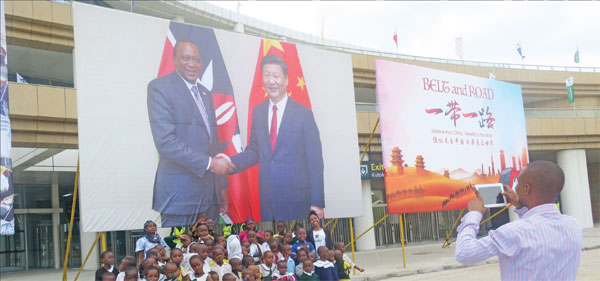Kenya celebrates launch of rail line
Kenya launched the long awaited Nairobi-Mombasa Standard-Gauge Railway passenger train service on May 31 in a colorful event held in the country's second-largest city.
The line is the third Chinese-built infrastructure project to be inaugurated in Africa after Nigeria officially commercialized its 186.5 kilometer Abuja-Kaduna SGR in July last year followed by the 750-km Ethiopia-Djibouti electric train in October.
President Uhuru Kenyatta flagged the 472-km train to start service an hour before midday. Together with the first lady, Deputy President William Ruto and high-level government officials, Kenyatta boarded the train bound for Nairobi from Mombasa.
In his keynote address, Kenyatta said the feat should not only be celebrated by Kenyans but East Africans at large, as it will transform the regional economy by improving the speed and capacity of rail transportation. He added that the $3.8 billion (3.4 billion euros; £2.9 billion) line will improve trans-border trade, as it lowers the cost of ferrying passengers and freight from the port of Mombasa to Nairobi and beyond to Uganda, Rwanda, South Sudan and the eastern parts of Democratic Republic of Congo.
|
Schoolchildren are photographed in front of giant banners at the Mombasa-Nairobi SGR launch ceremony in Mombasa. Lucie Morangi / China Daily |
"This infrastructure will not only unite Kenyans but also accelerate regional integration with our neighbors. It is indeed a milestone," Kenyatta said.
He expressed his gratitude to President Xi Jinping and the people of China for the collaborative effort that culminated in the success of the project.
"This is a testament to the comprehensive China-Kenya relationship, which is based on mutual benefits and a clear vision of win-win benefits. Kenya will continue pursuing a sustainable relationship with the Asian giant," Kenyatta said.
He emphasized that the completion of the railway, named the Madaraka Express, comes 54 years after the country attained self-rule, and it will complement the century-old meter gauge Kenya-Uganda railway. It is designed to run at 120 kilometers per hour for passengers and 80 km/h for freight, and will halve the duration of traveling and generate job opportunities.
Kenyatta disclosed that his government has lowered introductory fares to attract customers to the new transportation concept.
"Passengers will pay a minimum of $7 for a one-way journey during trial operations, while containers that have previously been charged an average of $1,000 will now pay 50 percent lower," he said.
Wang Yong, Xi's special envoy and a State Councilor, says: "This railway is an important early harvest outcome of the Belt and Road Initiative. It is also a landmark project of China-Africa cooperation on regional networks of high-speed rail, expressways, aviation African industrialization and industrial capacity."
He added that launching the SGR establishes a regional transportation artery and is a testament to the fact that the China-Kenya friendship has entered a new era of mutually beneficial cooperation.
In 2015, Xi and his Kenyan counterpart witnessed the signing of the agreement on financing the project. China financed 90 percent, with the remaining 10 percent funded by the Kenyan government.
"The infrastructure, once in use, is expected to improve speed and capacity of railway transport in Kenya, greatly improving trade between Mombasa and its vast hinterland, which includes Uganda, Rwanda, South Sudan and eastern parts of Democratic Republic of Congo," says Robert Kagiri, the director of the Center for Strategic Policy Management at Africa Policy Institute, a think tank based in Nairobi.
China Road and Bridge Corp, the builder of the SGR, will oversee management and operation of the infrastructure.
"Having a foreign country run the railway is a pathway to injecting professionalism from an experienced player," Kagiri says.
The Madaraka Express will feature two passenger trains leaving Nairobi and Mombasa at 8 am daily.



















